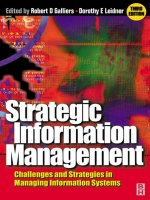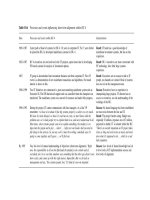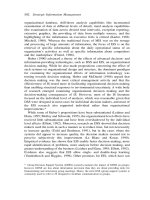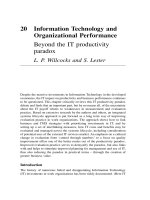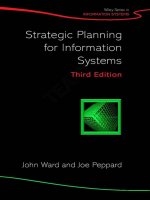Managing information systems 7th edition brow ch013
Bạn đang xem bản rút gọn của tài liệu. Xem và tải ngay bản đầy đủ của tài liệu tại đây (978.72 KB, 46 trang )
MANAGEMENT INFORMATION SYSTEMS
CHAPTER 13
LEADING THE INFORMATION SYSTEMS
FUNCTION
MANAGING THE IT ASSETS
Technology
Computer and communications infrastructure that enables
information sharing over standard IT platforms
Human Resources
IT people talent with appropriate skills mix
Business/IT Relationship
Partnering relationships between business and IT managers,
including joint decision-making
Copyright © 2011 Pearson Education, Inc. publishing as Prentice Hall
EVOLVING IS LEADERSHIP ROLE
• Executive IS leadership role has evolved over time due to:
– Rapid technological change
– Opportunities for strategic IT applications and business intelligence
– Increase in IT-savvy business managers
– Ubiquitous IT usage
Copyright © 2011 Pearson Education, Inc. publishing as Prentice Hall
TOP IS EXECUTIVE ISSUES IN 2010
1. Business productivity and cost reduction
2. Business agility and speed-to-market
3. IT and business alignment
4. IT reliability and efficiency
5. Business process re-engineering
Source: Survey of Society of Information Management members in mid-2010
Luftman and Ben-Zvi, MISQ Executive, Dec. 2010
Copyright © 2011 Pearson Education, Inc. publishing as Prentice Hall
IS ORGANIZATION RESPONSIBILITIES AND
GOVERNANCE
• IS GOVERNANCE
- Locus of decision-making and accountability for:
1) computer and network operations
2) application software (development of new applications and
maintenance of existing applications)
Copyright © 2011 Pearson Education, Inc. publishing as Prentice Hall
TWO PRIMARY IS RESPONSIBILITIES
Computer & Network Operations
Planning, purchasing, installing,
operating, and maintaining/upgrading:
- Computer hardware
- Systems software on which
applications software “runs”
- Local area networks and wide area
networks that support distributed computing
and telecommunications for the enterprise
Application Software Development &
Maintenance
- Acquiring (custom-developing,
purchasing or “renting”)
- Implementing
- Maintaining/upgrading
Application software for:
- the entire enterprise
- business units/departments
- smaller work groups
- individuals
Copyright © 2011 Pearson Education, Inc. publishing as Prentice Hall
IS GOVERNANCE ALTERNATIVES
• Centralized
Decision making and IS workers are concentrated within a central IS unit to take
advantage of economies of scale and opportunities for integration of IS resources
• Decentralized
Decision making and IS workers are dispersed to be closer to business managers
within highly autonomous business units and be responsive to their needs
• Federal
Combines both the centralized and decentralized designs to have the “best of both
worlds.” The most typical Federal design is:
– Centralized responsibilities for computer operations & networks
– Decentralized responsibilities for applications software
Copyright © 2011 Pearson Education, Inc. publishing as Prentice Hall
IS GOVERNANCE ALTERNATIVES
Fig 13.2
Copyright © 2011 Pearson Education, Inc. publishing as Prentice Hall
IS GOVERNANCE ALTERNATIVES
•
.
Another type of Federal IS governance design:
- Centralized for “Shared” resources (services & applications)
- Decentralized for “Local” IS resources
“Local” Applications
Software applications specific
to a business unit or function
Shared Applications
(Enterprise systems such as ERP, CRM)
Shared IT Services
Fig 13.1: Shared versus “Local” IS Resources
Copyright © 2011 Pearson Education, Inc. publishing as Prentice Hall
SHARED SERVICES IN A MULTINATIONAL FIRM
Shared Services Organization for Asia Pacific region at British America Tobacco
Source: Brown and Vessey, 2003
Copyright © 2011 Pearson Education, Inc. publishing as Prentice Hall
MANAGING IT SERVICE DELIVERY
Technology Tradeoff Decisions
- Equipment Location
- Client/Server Allocations
- Operating System Standards
- Network Redundancy
- Bandwidth Capacity
- Network Response Time
- Security, Privacy and Network Access
Copyright © 2011 Pearson Education, Inc. publishing as Prentice Hall
GREEN COMPUTING TRADEOFF DECISIONS
• Hydroelectric Power
• Virtualization Tools
• Thin Clients
• Enhanced sleep modes for microcomputers
• E-waste recycling
Copyright © 2011 Pearson Education, Inc. publishing as Prentice Hall
EXAMPLE: BECOMING GREEN WITH BUSINESS
INTELLIGIENCE
United Parcel Service
• Business intelligence helped identify ways for UPS to reduce idling times
of its delivery trucks, saving fuel and reducing pollution
- Creates fuel-efficient routes for its package delivery vehicles
- Cuts fuel consumption by monitoring and reducing idling time of
trucks at their delivery destinations
• Move from a scheduled maintenance program to a condition-based
maintenance program for its trucks
- Fewer truck breakdowns and fewer replacement parts required for the
vehicles, which eliminates waste
Copyright © 2011 Pearson Education, Inc. publishing as Prentice Hall
CHARGEBACK SYSTEMS
• Chargeback systems place control of IS spending with business
managers and enables them to better understand their true IT costs
• Examples of IT resources that can be part of chargeback costs:
- IS personnel (time spent and rate for specific skills)
- Computer usage (or computer cycles used)
- Disk file space (data storage costs based on type of storage unit)
- Number of transactions processed
- Amount of computer main memory used (per unit of time)
- Number of users of an application
Copyright © 2011 Pearson Education, Inc. publishing as Prentice Hall
CHARGEBACK SYSTEMS
Potential Benefits
Fig 13.4
Copyright © 2011 Pearson Education, Inc. publishing as Prentice Hall
CHARGEBACK SYSTEMS
• What makes a good
Chargeback System?
- Understandable
- Prompt and regular feedback
- Controllable
- Accountable
- Costs related to benefits
- Consistent with goals
Fig 13.5
Copyright © 2011 Pearson Education, Inc. publishing as Prentice Hall
SERVICE LEVEL AGREEMENTS (SLAs)
Service Level Agreements (SLAs)
Defines the client expectation for a specific type of IT service as well as
procedures to follow when these expectations are not met.
• Should include:
- A simple definition of the service to be provided (e.g., help desk support)
- The name(s) and contact information of IS personnel to contact for this service
- A table listing the services to be provided and their costs (e.g., how quickly
different types of problems will be responded to, and the costs associated with
providing this type of service level)
- Escalation procedures (e.g., who to contact if the agreed upon service response is
not being provided)
- A sign-off page for the appropriate business client and the IS liaison preparing the
SLA document
Copyright © 2011 Pearson Education, Inc. publishing as Prentice Hall
IT SERVICE MANAGEMENT with ITIL
• Information Technology Infrastructure Library (ITIL)
- Processes that focus on the business aspect of IT service delivery created by the British Office of Government Commerce
- Describes how various IT processes should be performed to ensure
outcomes such as:
- Adequate computer capacity exists for new IT applications or other IT
infrastructure changes
- Tracking of a computer incident from the time it first appears until a
system change is made to permanently fix the problem
- Formal change management process are followed for changes to any
component of an IT system
ITIL Official Site
Copyright © 2011 Pearson Education, Inc. publishing as Prentice Hall
IT SERVICE DELIVERY:
SUPPORTING COMPUTER USERS
• IT support for employees using computer tools, including
those developing software applications with these tools
• Key principle:
- Unique aspects of the
organization, as well as the different
support needs of work units and
computer users, need to be taken into
account when designing strategies
and tactics for user support
FigHall
13.6 Framework for Designing User Support
Copyright © 2011 Pearson Education, Inc. publishing as Prentice
STRATEGIES FOR SUPPORTING USER COMPUTING
1.Laissez-Faire (“hands-off”)
2. Acceleration
3. Containment
4. Controlled Growth
Fig 13.7 Strategies for User Computing
Copyright © 2011 Pearson Education, Inc. publishing as Prentice Hall
STRATEGIES FOR SUPPORTING USER COMPTING
Laissez-faire
• “Hands off” approach: low levels of control but also few resources for
support
• Common in 1980s when PCs were first introduced into corporations:
IT leaders did not attempt to support or control their introduction.
• Today: approach may be used with new personal technologies
Acceleration
• Low levels of formal controls and significant investments in resources
to support users, to promote growth in tool usage
• The goal is to encourage users to acquire and learn about computer
tools, including developing their own applications, before introducing
heavy control policies
Copyright © 2011 Pearson Education, Inc. publishing as Prentice Hall
STRATEGIES FOR SUPPORTING USER COMPTING
Containment
• Risk adverse approach with high levels of formal controls and
procedures, including strict policies for tool security
• Appropriate for highly regulated environments to be sure policies
and procedures are formulated and enforced
Controlled Growth
• Combines high levels of formal controls and procedures with
significant investments in resources
• Considered to be the ideal, mature approach: organizations initially
begin with a different strategy and then migrate to controlled growth
Copyright © 2011 Pearson Education, Inc. publishing as Prentice Hall
SERVICE LEVEL AGREEMENTS FOR DESKTOP SUPPORT
• Speed in responding to user requests is a key performance metric
• Different support levels based on the problem type are established in
consultation with business unit managers
• Different types of problems will have different maximum time
periods in which they should be solved
Fig 13.8
Copyright © 2011 Pearson Education, Inc. publishing as Prentice Hall
COMMON SUPPORT SERVICES
Fig 13.9
Copyright © 2011 Pearson Education, Inc. publishing as Prentice Hall
COMMON POLICIES AND PROCEDURES
• Establishing technology “standards” is typically an IS department
responsibility, but some organizations have committees with business unit
representatives to establish policies
• Organizations communicate the policies and procedures to new
employees via orientation programs
• Control Policies have to be modified in response to new technologies,
ways of working, new laws and new external threats
Fig 13.10 Common Policies and Procedures
Copyright © 2011 Pearson Education, Inc. publishing as Prentice Hall

